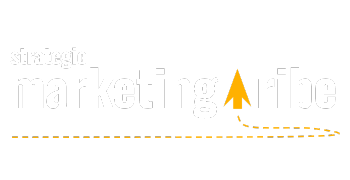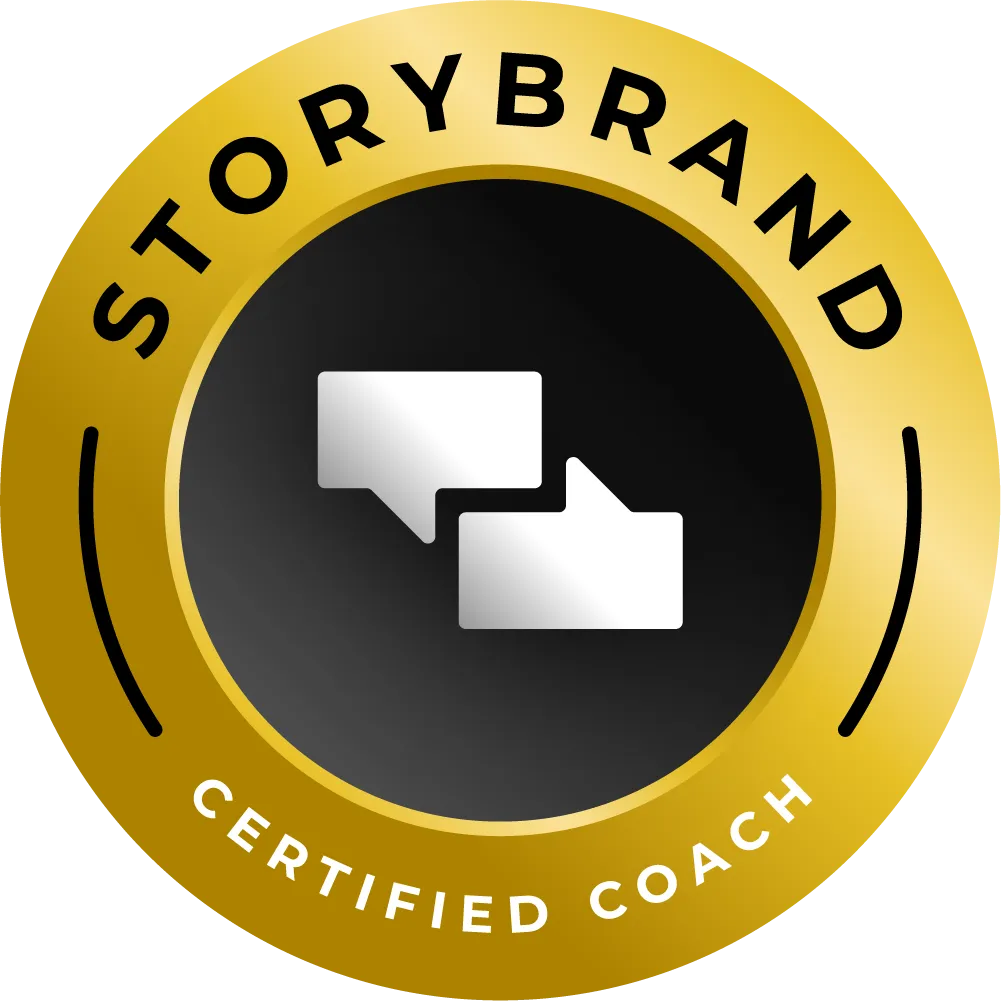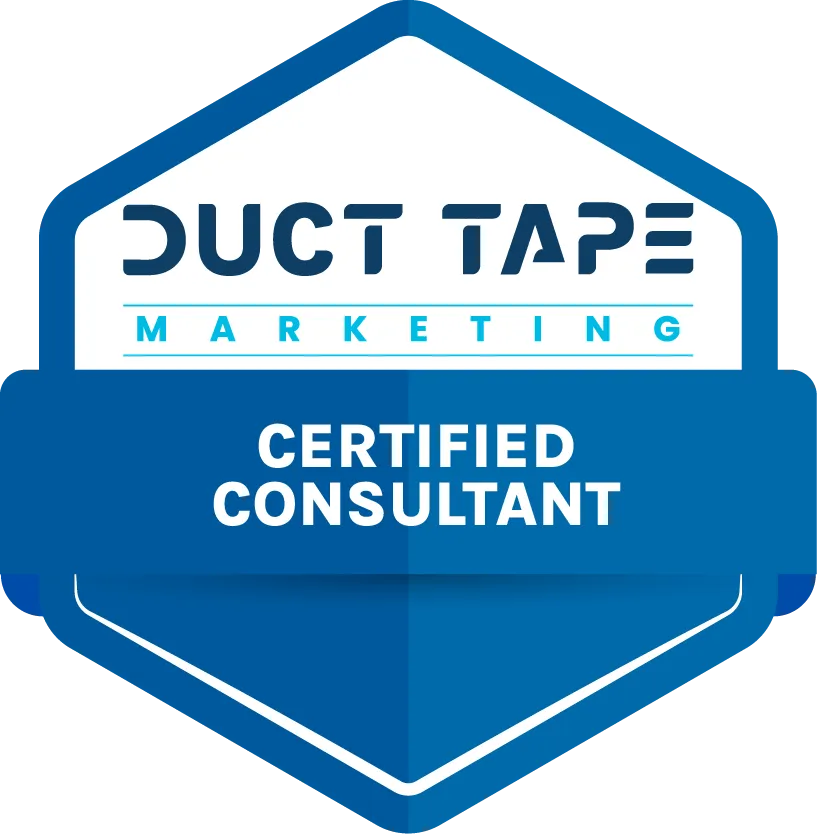StoryBrand Marketing Agency
Is Your Marketing Message So Confusing Even Your Own Mom Doesn’t Get It?
We're an award-winning StoryBrand Marketing Agency that helps Service Businesses clarify their messaging so everyone wants to work with you!
✓ Build trust and authority in your industry
✓ Connect with CLIENTS WHO ACTUALLY GET IT
✓ MARKETING THAT FEELS NATURAL
WATCH THIS VIDEO
If your message isn’t landing—and the right clients aren’t showing up—it’s not your fault. Most service business owners are great at what they do. They just struggle to talk about it clearly.
In this video, I’ll walk you through how we fix that using the StoryBrand Framework, plus how to get started with either DIY or done-for-you options.

WHAT HAPPENS WHEN YOUR MESSAGE ISN’T CLEAR
Can your mom explain what you do?
Can you easily explain what you do?
Can anyone?
If not, that's the problem we fix.
Because when people don’t understand what you do, they move on. You end up working harder just to stay in the game.
You’re always re-explaining yourself
Your website doesn’t convert visitors into clients
Your leads aren’t the right fit
Referrals become scarce
Marketing is frustrating as all hell
But it doesn’t have to be this way. A clear message makes all of that easier. It’s the difference between chasing leads—and attracting the right ones.
You might not believe it yet, but marketing can actually be the opposite of frustrating when you're doing it right.
MAKE YOUR MARKETING Simpler
Whether you want to learn the system or hand it over completely, the goal is the same: clear messaging that brings in better clients with less effort.

A DIY SYSTEM THAT’S SIMPLE TO FOLLOW

for weekly group coaching, templates, and a proven system that fits seamlessly into your week—without taking over your life.
.

COACHING THAT MEETS YOU WHERE YOU ARE

Want someone to walk you through it? Get 1:1 or team coaching to clarify your message and apply the StoryBrand Framework to your business in real time.
.

DONE-FOR-YOU MARKETING

Too busy to do it yourself? We’ll build your messaging, write your copy, create the assets you need, and handle your StoryBrand marketing—so you can stay focused on running your business.
HI, I'm Vicky Sidler
And I’VE BEEN WHERE YOU ARE

I know how it feels to stare at your marketing and think, “Why isn’t this working?” That's why I created a StoryBrand Marketing Agency.
All in all, your business isn’t just another brick in the wall—it’s something special. Your story matters, and I’m here to help you share it in a way that feels real, connects with people, and gets results.
As a certified StoryBrand Guide, I specialize in turning complicated ideas into clear, compelling messages that resonate with your audience.
With a background in journalism, I’ve spent decades telling stories that matter and crafting content people want to read.
I’ve developed a proven system to help businesses like yours cut through all the AI trash that's out there and build genuine connections with their audience.
Your story isn’t just important—it’s the reason people will choose your business. Let’s make sure it’s heard loud and clear by the people who need it most.
And sorry if I got Pink Floyd stuck in your head just now...
Hear Directly from DONALD MILLER
In this short clip, StoryBrand’s founder Donald Miller explains why clear messaging and a simple marketing plan change everything.
Donald shares why newsletters are back, what a full StoryBrand campaign includes, and how a certified guide helps you focus on what actually works—without wasting money or time.
Watch to see how working with a StoryBrand Certified Guide can make a measurable difference for your business.

EVERYTHING STORYBRAND, ALL IN ONE PLACE
Whether you need help with strategy, websites, content, or SEO, I offer the full range of StoryBrand marketing services—done with you or done for you.
StoryBrand Framework
StoryBrand Wireframe
StoryBrand Websites
StoryBrand SEO
StoryBrand Video
StoryBrand Copywriting
StoryBrand Email Sequences
StoryBrand Marketing Funnels
StoryBrand Workshops
StoryBrand Consulting
StoryBrand PPC
StoryBrand Lead Generation
StoryBrand
Social Media
StoryBrand Strategy
StoryBrand Content Marketing
StoryBrand Local Service
StoryBrand Coaching
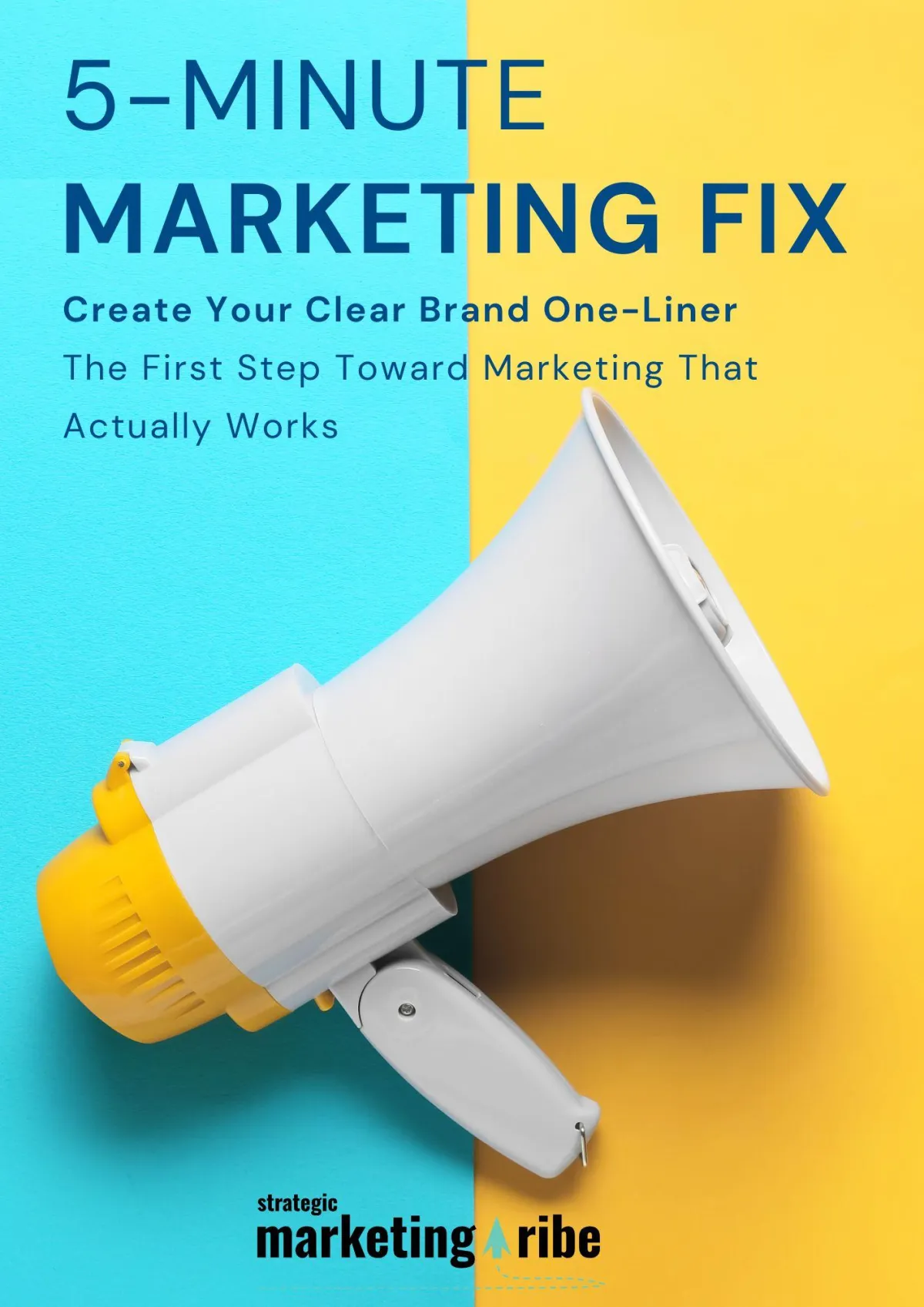
MARKETING THAT DOESN’T TAKE OVER YOUR LIFE
Whether you want to build it yourself or hand it off completely, as a StoryBrand Marketing Agency, we’ll give you a clear message and a simple system that actually works.

1
BOOK A COFFEE CHAT
This is a no-pressure, non-sales call where we discuss what’s working, what’s not, and where you want to go.
.

2
CHOOSE YOUR PATH
Get hands-on support through the StoryBrand Course, 1:1 or team coaching, or let me build the entire marketing system for you—messaging, website, emails, and more.
.
.

3
FIX YOUR MARKETING
Walk away with a message that resonates, a plan that’s easy to follow, and marketing that works while you sleep and finally delivers results.
COFFEE’S ON ME (OK, NOT REALLY)
But I'm serious about helping you connect with your audience. Let’s grab a coffee (on Zoom) and chat about your marketing goals.
Wondering how to simplify your message? Let’s talk.
Ready to stand out in an AI-saturated world? I’ve got ideas.
Just need clarity? I’ll help you see the big picture.
This isn’t a sales call—just a friendly, low-pressure chat. At the very least, you’ll walk away with some cool ideas you can try on your own.
SCHEDULE YOUR COFFEE CHAT WITH ME (VICKY) TODAY
FIXING YOUR MARKETING SHOULDN’T FEEL IMPOSSIBLE

Most small business owners aren’t marketers—they just want to explain what they do in a way that makes people care.
But when the message isn’t clear, everything else gets harder: websites don’t convert, leads go cold, and social posts fall flat.
You might worry that getting it right will take too much time, cost too much money, or feel like just another online course you’ll never finish.
That’s why I offer three simple paths: do-it-together support through the StoryBrand Course, 1:1 and team coaching, or done-for-you services where I build your full funnel myself.
You’ll get clear messaging, practical templates, and real support—so your marketing finally works and your business actually grows.
YOUR QUESTIONS, ANSWERED
We know marketing can feel overwhelming, and you probably have questions. That’s why we’ve put together answers to the things people ask us most.
What makes Strategic Marketing Tribe different from other StoryBrand marketing agencies?
We’re the StoryBrand marketing agency that skips the boring "corporate speak." We blend the power of StoryBrand with strategic marketing solutions to craft content that feels human, genuine, and impossible to ignore.
How can your strategic marketing solutions benefit my business?
Our strategic marketing solutions simplify your message, clarify your brand story, and help you connect with your ideal customers. It’s marketing that makes sense and gets results – no jargon, no gimmicks, just growth.
What is StoryBrand, and why does it matter?
Think of StoryBrand as a cheat sheet for marketing clarity. It helps you explain what you do in a way that makes people stop, listen, and say, “Oh, I get it.” We use it to create marketing that feels human and that your audience will actually enjoy reading.
Do I need to be familiar with StoryBrand to work with you?
Not at all! Whether you’re a StoryBrand superfan (like us!) or have no idea what it is, we’ll walk you through everything. We’re here to make the process simple, clear, and (dare we say) fun.
How do I know if this is right for my business?
If people keep saying “I don’t really get what you do,” or you’re getting the wrong kind of leads, it’s a sign your message needs work. That’s what we fix.
What if I don’t have time to take a course?
The course is built for time-strapped business owners. You get short lessons, plug-and-play templates, and live support so you’re never stuck or overwhelmed.
What’s the difference between the course and the done-for-you service?
The course gives you training, tools, and weekly support so you can do it yourself. The done-for-you option means I build your whole funnel for you.
How long does it take to see results?
Most people see clearer messaging and better engagement within a week of applying the one-liner. Bigger results (like leads and conversions) follow as you apply it across your marketing.
What if I’ve already tried StoryBrand and it didn’t work?
Many people try to apply StoryBrand on their own and miss key parts. This course walks you through it step-by-step, with real examples and live feedback from a Certified Guide.
STORY, MEET STRATEGY
Let’s make marketing feel less robotic and more real. Find resources from a StoryBrand Marketing Agency that bring your message—and your business—to life.

Most People Can’t Spot AI Ads—Why That Matters for Your Brand
By Vicky Sidler | Published 22 September 2025 at 12:00 GMT+2
If you think your customers can tell whether your ad was made by a human or a robot, you might be giving them too much credit.
Almost no one can spot an AI ad. Literally.
A new study from Magic Hour found that 98.6% of Americans couldn’t correctly identify which ads were AI-generated. And that’s despite 85% saying they were confident they could.
So if you’ve been quietly using AI tools to whip up your content—odds are, your audience doesn’t even realise it. And for the most part, they’re not bothered.
But. Before you start replacing faces with avatars, remember what happened to Guess in Vogue. Their AI-generated model ad blew up—for all the wrong reasons. People saw it as tone-deaf, fake, and out of touch with the brand's values.
And that’s the real lesson here.
TL;DR:
99% of people can’t identify AI ads
60% say it wouldn’t reduce trust in a brand
But some groups (like women 45+) are less forgiving
Transparency builds trust. Hiding AI use doesn’t
AI is fine—as long as your message stays clear and on-brand
👉 Need help getting your message right? Download the 5-Minute Marketing Fix
Table of Contents:
Most People Can’t Spot AI Ads—Why That Matters for Your Brand
Most People Are Guessing—Literally:
Most Reactions Are Curious—Not Outraged:
A Quick Reality Check From Me:
AI Tools Are Useful. But They’re Not a Personality.
Transparency Isn’t Optional Anymore:
So, Should You Use AI in Your Marketing?
1. Meta’s AI Flirts With Kids—What That Tells Us About Trust
2. ChatGPT Adds Parental Controls After Teen Tragedy
3. Vogue’s AI Model Ad Backfires—Marketing Lessons for Small Businesses
4. Why 95% of AI Pilots Fail and What to Do Instead
5. AI vs Human Creativity in Problem Solving: What Works Best?
FAQs on AI-Generated Ads and Brand Trust
How many people can actually spot an AI-generated ad?
Do people trust brands less if they use AI-generated ads?
Should small businesses disclose when content is made with AI?
What’s the risk of not disclosing AI use?
Is it okay to use AI in marketing at all?
Most People Are Guessing—Literally:
In Magic Hour’s test, respondents were shown four ads and asked which were made by AI. Only 1.4% got them all right.
Even digital natives flopped: 93% of under-30s said they were confident—but less than 2% passed. Confidence didn’t help older folks either. Many thought real images were fake.
Bottom line: if your ad looks polished and makes sense, most people don’t question the method.
Most Reactions Are Curious—Not Outraged:
When people learned an ad was AI-generated, the top emotions were curiosity and interest—not anger. Even those who felt deceived were in the minority.
Younger audiences were more likely to feel impressed. Older adults? A bit more sceptical, but not dramatically so.
The Guess × Vogue backlash a few weeks ago shows the limits, though. The issue wasn’t just that Guess used an AI model in its Vogue ad—it was that it felt fake in a way that clashed with the brand's image and values.
A Quick Reality Check From Me:
I looked at the AI ads used in the Magic Hour study (you can do so too, here)—and I’ll be honest, they were very well done. No weird hands. No glassy eyes. No tell-tale fingers doing math on their own. Whoever picked those examples wasn’t trying to make it easy to spot the fakes. And that’s important to note.
Yes, there’s a growing body of AI content that’s hard to distinguish from human-made work. But there’s also a mountain of it that still has the watermarks—awkward lettering, off-brand tone, and visuals that feel “off” in a way most people can’t articulate but instinctively don’t trust.
That’s why I stand by what I wrote earlier this month in “AI Marketing Trust Gap Widens”: AI isn’t the problem. Misuse is. People don’t mistrust tools—they mistrust how brands use them.
So yes, the study shows most people can’t spot AI ads when they’re done well. But the moment your message feels fake or your tone goes flat, your audience might not know it’s AI—but they’ll definitely feel like something’s off.
Use the tools. Just don’t hand them the keys to your voice.
AI Tools Are Useful. But They’re Not a Personality.
I recently tested an AI avatar for my daily videos. I thought it might help me save time and still show up consistently. But I couldn’t do it. First, the quality wasn’t great. But more importantly, it didn’t feel like me.
Authenticity is one of my core principles. I do use AI in the background—to help script, organise, and polish. But putting a digital version of myself on camera felt off-brand. Not wrong for everyone. Just wrong for me.
The tech’s impressive. But it’s not a shortcut to trust.
Transparency Isn’t Optional Anymore:
Over 90% of people said they want AI-generated ads to be labeled. Most don’t trust companies to regulate themselves—nor should they.
We’ve already seen what happens when the big platforms write their own rules. Meta’s internal policy once allowed AI bots to flirt with teenagers and spread racist junk as long as it was wrapped in technical disclaimers. OpenAI only added parental controls to ChatGPT after a teen took his life following months of AI conversations about self-harm.
These aren’t fringe cases. They’re warnings.
So if you’re using AI in your business—even just to make ads or write copy—be transparent. Say what’s AI-generated. Don’t hide it in the footer or behind vague phrasing.
Trust is hard to earn. Hiding how your content was made won’t help.
If the message is solid, the tool that helped shape it won’t be the problem.
So, Should You Use AI in Your Marketing?
If it helps you stay consistent, save time, or move faster—yes. But don’t use it to replace what makes your brand human. Use it to support the message, not distort it.
Your customers aren’t sitting around scanning every pixel. They’re looking for a message that makes sense and a brand they can believe in.
That’s where my 5-Minute Marketing Fix can help. It’s a free tool that will help you to write a one-liner that builds trust—even if your next ad was made by a robot.
Related Articles:
1. Meta’s AI Flirts With Kids—What That Tells Us About Trust
If 90% of people want AI ads labelled, this article explains why. Meta’s chatbot policy allowed deeply inappropriate content—showing exactly why trust should never be outsourced to tech platforms.
2. ChatGPT Adds Parental Controls After Teen Tragedy
OpenAI only acted after a teen’s death. This post breaks down why emotional tone, disclaimers, and vague AI outputs create real-world risks—even for small businesses using “harmless” tools.
3. Vogue’s AI Model Ad Backfires—Marketing Lessons for Small Businesses
Curious why some AI ads spark backlash while others don’t? This case study of Guess’s Vogue ad explains exactly what happens when AI use clashes with brand values and public trust.
4. Why 95% of AI Pilots Fail and What to Do Instead
Most AI campaigns flop—not because AI doesn’t work, but because brands use it without a clear strategy. If you’re considering AI in your marketing, read this first.
5. AI vs Human Creativity in Problem Solving: What Works Best?
This Harvard-backed post shows why AI should support—not replace—your ideas. It’s a practical read for anyone trying to use AI tools without losing the human touch that makes marketing work.
FAQs on AI-Generated Ads and Brand Trust
How many people can actually spot an AI-generated ad?
Almost none. In a recent test by Magic Hour, only 1.4% of Americans could correctly identify which ads were made with AI—even though 85% said they were confident they could.
Do people trust brands less if they use AI-generated ads?
Most don’t. About 60% of consumers said they’d trust a brand the same or even more after finding out it used AI ads. That said, certain groups—especially women aged 45+—are more cautious.
Should small businesses disclose when content is made with AI?
Yes. Over 90% of people want AI-generated content to be labelled, and most don’t trust businesses to regulate themselves. Disclosing AI use builds credibility—especially when your audience values honesty.
What’s the risk of not disclosing AI use?
You risk losing trust. It’s not just about how good the content looks. If your audience feels misled or like the content doesn’t match your values, it can damage your brand. The Guess × Vogue backlash is a good example of this.
Is it okay to use AI in marketing at all?
Yes—as long as it supports your message rather than replacing your voice. AI can help with scripting, visuals, or speed. Just don’t let it take over the parts of your brand that need to feel real and human.
Why shouldn’t companies self-regulate AI use?
Because they’ve shown they can’t be trusted to. Meta allowed bots to flirt with teenagers. OpenAI waited until after a teen tragedy to add basic safety features. If the tech giants get it this wrong, small businesses need to be extra thoughtful.
How can I build trust with my audience while using AI?
Start with a clear, authentic message. Be transparent about how you use AI. Use it to enhance what you’re already doing—not to cut corners. And if you’re not sure what to say?
👉Download the 5-Minute Marketing Fix to write one powerful sentence that builds trust across every channel.
Created with clarity (and coffee)

